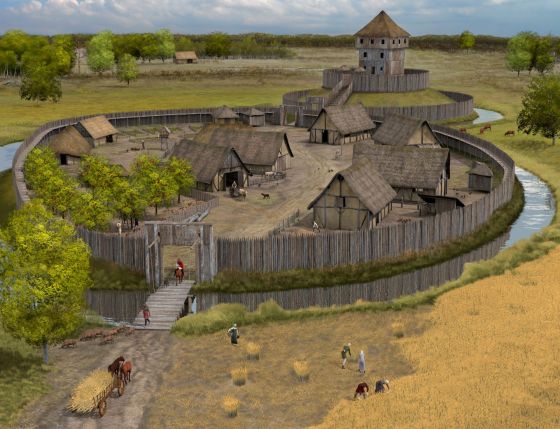Difference between revisions of "Bailey"
Tao alexis (talk | contribs) (Created page with "A '''bailey''' describes various evolutions of a wooden or stone fortification intended to enclose a hamlet or yard that might include a bakery, kitchen, chapel, storehouses,...") |
Tao alexis (talk | contribs) |
||
| Line 1: | Line 1: | ||
| + | [[File:Bailey and Motte.jpg|right|560px|thumb]] | ||
A '''bailey''' describes various evolutions of a wooden or stone fortification intended to enclose a hamlet or yard that might include a bakery, kitchen, chapel, storehouses, stables, barracks, forges and woodshops. In it original form, the "bailey" describes a simple palisade wall that may or may not include a [[Ditches & Moats|protective ditch]]. With time, as a settlement grows, the original construction is replaced with stone construction. Many early baileys include an adjoined defensive mound called a "motte," which is later fashioned into a citadel. Eventually, the bailey and motte are transformed into a full castle — though castles that are built whole still use the terminology of "bailey" to describe one or more yards connected to the main fortification. | A '''bailey''' describes various evolutions of a wooden or stone fortification intended to enclose a hamlet or yard that might include a bakery, kitchen, chapel, storehouses, stables, barracks, forges and woodshops. In it original form, the "bailey" describes a simple palisade wall that may or may not include a [[Ditches & Moats|protective ditch]]. With time, as a settlement grows, the original construction is replaced with stone construction. Many early baileys include an adjoined defensive mound called a "motte," which is later fashioned into a citadel. Eventually, the bailey and motte are transformed into a full castle — though castles that are built whole still use the terminology of "bailey" to describe one or more yards connected to the main fortification. | ||
Revision as of 02:23, 29 December 2022
A bailey describes various evolutions of a wooden or stone fortification intended to enclose a hamlet or yard that might include a bakery, kitchen, chapel, storehouses, stables, barracks, forges and woodshops. In it original form, the "bailey" describes a simple palisade wall that may or may not include a protective ditch. With time, as a settlement grows, the original construction is replaced with stone construction. Many early baileys include an adjoined defensive mound called a "motte," which is later fashioned into a citadel. Eventually, the bailey and motte are transformed into a full castle — though castles that are built whole still use the terminology of "bailey" to describe one or more yards connected to the main fortification.
